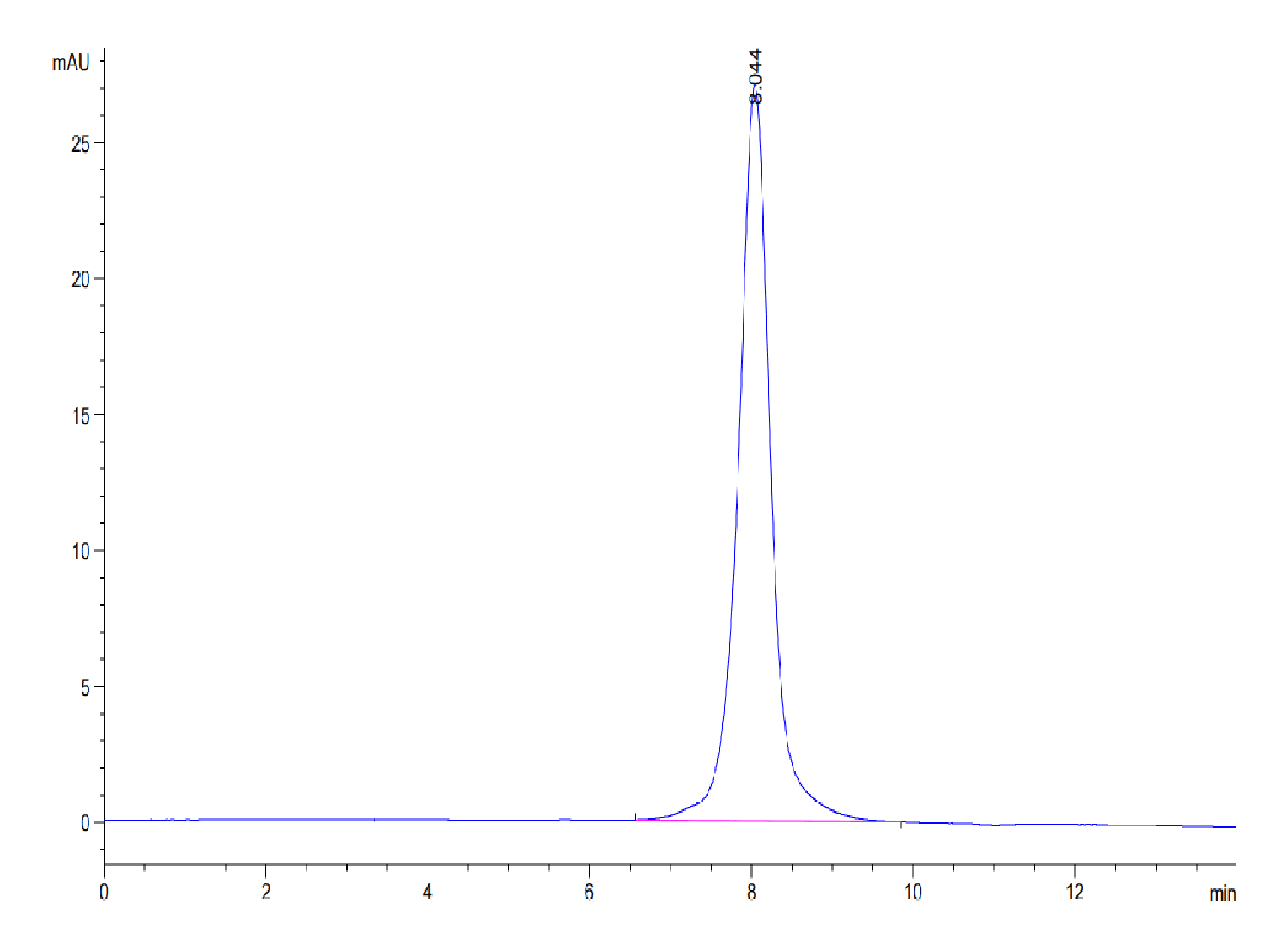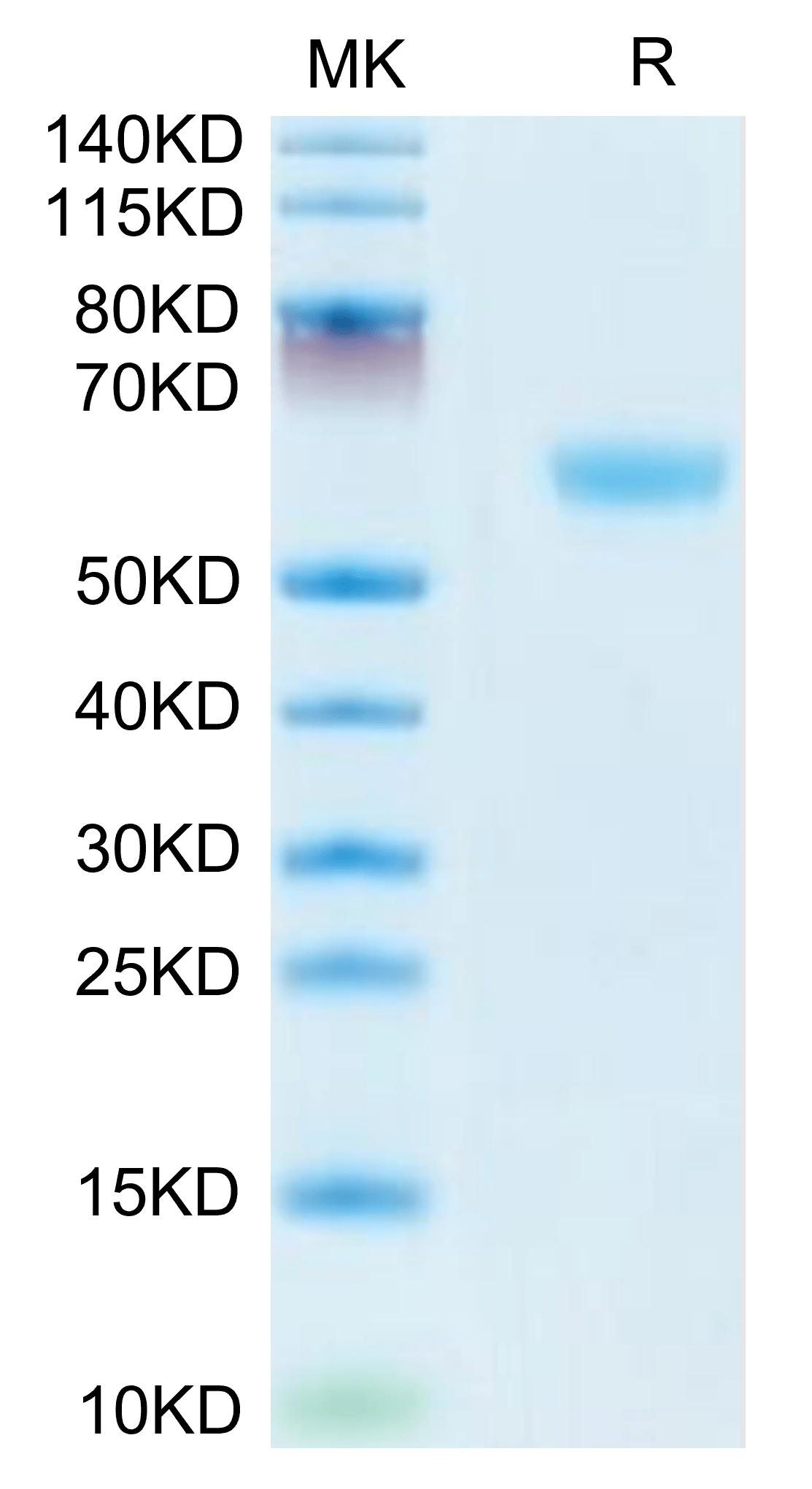| Weight | 1 lbs |
|---|---|
| Dimensions | 9 × 5 × 2 in |
| accession | O88875 |
| express system | HEK293 |
| product tag | C-hFc |
| purity | > 95% as determined by Tris-Bis PAGE;> 95% as determined by HPLC |
| background | CD160 (also Natural killer cell receptor BY55) is a 27 ‑ 30 kDa member of the Ig superfamily. In human, it is expressed principally on nonmyeloid hematopoietic cells. CD160 antigenis a receptor on immune cells capable to deliver stimulatory or inhibitory signals that regulate cell activation and differentiation. Exists as a GPI-anchored and as a transmembrane form, each likely initiating distinct signaling pathways via phosphoinositol 3-kinase in activated NK cells and via LCK and CD247/CD3 zeta chain in activated T cells. |
| molecular weight | The protein has a predicted MW of 41.8 kDa. Due to glycosylation, the protein migrates to 55-65 kDa based on Tris-Bis PAGE result. |
| available size | 100 µg, 500 µg |
| endotoxin | Less than 1EU per μg by the LAL method. |
Mouse CD160 Protein 3821
$240.00 – $800.00
Summary
- Expression: HEK293
- Pure: Yes (HPLC)
- Amino Acid Range: Gly28-Ser160
Mouse CD160 Protein 3821
| protein |
|---|
| Size and concentration 100, 500µg and lyophilized |
| Form Lyophilized |
| Storage Instructions Valid for 12 months from date of receipt when stored at -80°C. Recommend to aliquot the protein into smaller quantities for optimal storage. Please minimize freeze-thaw cycles. |
| Storage buffer Shipped at ambient temperature. |
| Purity > 95% as determined by Tris-Bis PAGE |
| target relevance |
|---|
| CD160 (also Natural killer cell receptor BY55) is a 27 - 30 kDa member of the Ig superfamily. In human, it is expressed principally on nonmyeloid hematopoietic cells. CD160 antigenis a receptor on immune cells capable to deliver stimulatory or inhibitory signals that regulate cell activation and differentiation. Exists as a GPI-anchored and as a transmembrane form, each likely initiating distinct signaling pathways via phosphoinositol 3-kinase in activated NK cells and via LCK and CD247/CD3 zeta chain in activated T cells. |
| Protein names CD160 antigen (Natural killer cell receptor BY55) (CD antigen CD160) [Cleaved into: CD160 antigen, soluble form] |
| Gene names Cd160,Cd160 By55 |
| Mass 10090Da |
| Function [CD160 antigen]: Receptor on immune cells capable to deliver stimulatory or inhibitory signals that regulate cell activation and differentiation. Exists as a GPI-anchored and as a transmembrane form, each likely initiating distinct signaling pathways via phosphoinositol 3-kinase in activated NK cells and via LCK and CD247/CD3 zeta chain in activated T cells (By similarity). Receptor for both classical and non-classical MHC class I molecules (PubMed:16177084). Receptor or ligand for TNF superfamily member TNFRSF14, participating in bidirectional cell-cell contact signaling between antigen presenting cells and lymphocytes. Upon ligation of TNFRSF14, provides stimulatory signal to NK cells enhancing IFNG production and anti-tumor immune response (PubMed:25711213). On activated CD4+ T cells, interacts with TNFRSF14 and down-regulates CD28 costimulatory signaling, restricting memory and alloantigen-specific immune response (By similarity). In the context of bacterial infection, acts as a ligand for TNFRSF14 on epithelial cells, triggering the production of antimicrobial proteins and pro-inflammatory cytokines (PubMed:22801499).; [CD160 antigen, soluble form]: The soluble GPI-cleaved form, usually released by activated lymphocytes, might play an immune regulatory role by limiting lymphocyte effector functions. |
| Subellular location [CD160 antigen]: Cell membrane ; Lipid-anchor, GPI-anchor .; [CD160 antigen, soluble form]: Secreted. Note=Released from the cell membrane by GPI cleavage. |
| Tissues Expressed in resting and activated NK cell subsets (at protein level) (PubMed:16177084, PubMed:25711213). Expressed in resting NKT cells (at protein level) (PubMed:16177084). Expressed in activated CD8+ T cells (at protein level). Highly expressed in intraepithelial lymphocyte (IEL) subsets, particularly in innate-like CD8A-positive IELs (at protein level) (PubMed:22801499). |
| Structure Homomultimer; disulfide-linked (By similarity). Interacts with classical and non-classical MHC class I molecules (PubMed:16177084). Interacts with TNFRSF14 (via cysteine-rich domain 1); this interaction is direct (PubMed:18193050). Interacts with LCK and CD247/CD3 zeta chain (By similarity). |
| Target Relevance information above includes information from UniProt accession: O88875 |
| The UniProt Consortium |
Data
 |
| The purity of Mouse CD160 is greater than 95% as determined by SEC-HPLC. |
 |
| Mouse CD160 on Tris-Bis PAGE under reduced condition. The purity is greater than 95%. |
Publications
Publications
| pmid | title | authors | citation |
|---|---|---|---|
| We haven't added any publications to our database yet. | |||
Protocols
| relevant to this product |
|---|
Documents
| # | ||
|---|---|---|
| Please enter your product and batch number here to retrieve product datasheet, SDS, and QC information. | ||














